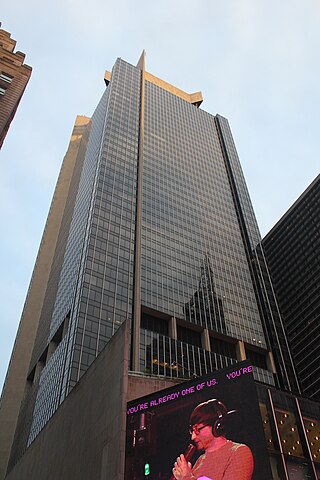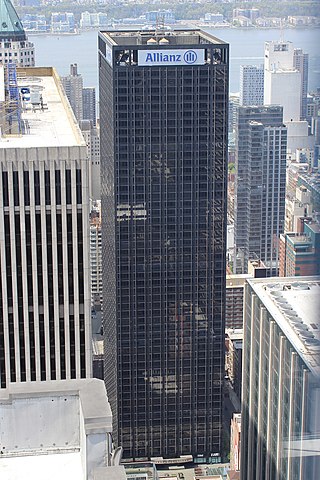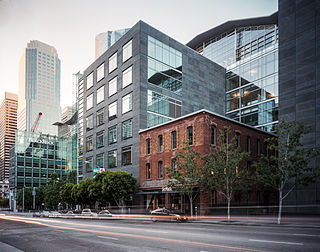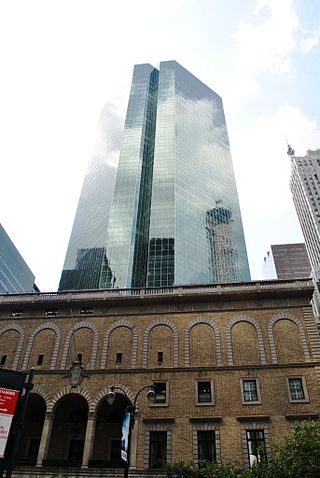
The Columbia Center, formerly named the Bank of America Tower and Columbia Seafirst Center, is a skyscraper in downtown Seattle, Washington, United States. The 76-story structure is the tallest building in Seattle and the state of Washington, reaching a height of 933 ft (284 m). At the time of its completion, the Columbia Center was the tallest structure on the West Coast; as of 2017, it is the fourth-tallest, behind buildings in Los Angeles and San Francisco.

One Worldwide Plaza is the largest tower of Worldwide Plaza, a three-building commercial and residential complex in the Hell's Kitchen neighborhood of Manhattan in New York City. Designed by David Childs of Skidmore, Owings & Merrill (SOM), One Worldwide Plaza measures 778 feet (237 m) tall and has an alternative address of 825 Eighth Avenue. The tower is the easternmost building in the complex, which occupies the entire city block bounded by Eighth Avenue, Ninth Avenue, 49th Street, and 50th Street and is built on the site of New York City's third Madison Square Garden. Adjacent to One Worldwide Plaza to the west are a public plaza and two residential buildings.

The San Francisco Ferry Building is a terminal for ferries that travel across the San Francisco Bay, a food hall and an office building. It is located on The Embarcadero in San Francisco, California and is served by Golden Gate Ferry and San Francisco Bay Ferry routes.

A setback, in the specific sense of a step-back, is a step-like form of a wall or other building frontage, also termed a recession or recessed story. Importantly, one or more step-backs lowers the building's center of mass, making it more stable. A setback as a minimum one-bay indent across all stories is called a recessed bay or recess and is the more common exterior form of an alcove.

Olympic Tower is a 51-story, 620 ft-tall (190 m) building at 641 and 645 Fifth Avenue, between 51st and 52nd Streets, in the Midtown Manhattan neighborhood of New York City. Designed by Skidmore, Owings & Merrill (SOM), the mixed-use development contains condominium apartments, office space, and retail shops. The tower is named after Olympic Airways, whose president Aristotle Onassis jointly developed the tower with the Arlen Realty and Development Corporation between 1971 and 1974. It was the first skyscraper to be constructed within a special zoning district to encourage retail and mixed-use development along Fifth Avenue.

One Astor Plaza, also known as 1515 Broadway and formerly the W. T. Grant Building, is a 54-story office building on Times Square in the Theater District of Midtown Manhattan in New York City. Designed by Der Scutt of Ely J. Kahn & Jacobs, the building was developed by Sam Minskoff and Sons. One Astor Plaza occupies a site bounded by Broadway to the east, 45th Street to the north, Shubert Alley to the west, and 44th Street to the south. The building is named for the Hotel Astor, which had occupied the site from 1904 to 1967. SL Green Realty and Allianz own One Astor Plaza, which as of 2022 serves as the headquarters for Paramount Global.

Paley Park is a pocket park located at 3 East 53rd Street between Madison and Fifth Avenues in Midtown Manhattan, New York City, on the former site of the Stork Club. Designed by the landscape architectural firm of Zion Breen Richardson Associates, it opened May 23, 1967. Paley Park is often cited as one of the finest urban spaces in the United States.

3 Park Avenue is a mixed-use office building and high school erected in 1973 on Park Avenue in Manhattan, New York City. The building, surrounded on three sides by a plaza, is categorized as a Midtown South address in the Kips Bay, Manhattan, Murray Hill, and Rose Hill neighborhoods. It is located between East 33rd and 34th Streets, close to the 33rd Street subway station, an entrance to which is built into the building.

The 1916 Zoning Resolution in New York City was the first citywide zoning code in the United States. The zoning resolution reflected both borough and local interests, and was proposed after the Equitable Building was erected in Lower Manhattan in 1915.

Seattle Municipal Tower is a skyscraper in downtown Seattle, Washington. At 220.07 m (722.0 ft), it is the fifth-tallest building in the city. Completed in 1990, it was initially named AT&T Gateway Tower and subsequently KeyBank Tower after its anchor tenants AT&T and KeyBank. It was given its current name on May 17, 2004.

The Residences at The Ritz-Carlton is a luxury residential skyscraper in Center City in Philadelphia, Pennsylvania. At 518 feet (158 m), the 48-story skyscraper is the twelfth-tallest building in Philadelphia, and the tallest residential tower in the city. The building was erected on the former site of One Meridian Plaza which was seriously damaged by a deadly fire in 1991. One Meridian Plaza was demolished in 1999 and the property was sold by E/R Partners to the Arden Group the next year. Development of the site by the Arden Group, which owns the adjacent Ritz-Carlton Philadelphia, was delayed for years as a result of a feud with rival developer Mariner Commercial Properties. Mariner owned the property 1441 Chestnut Street, which sits south of the Residences at The Ritz-Carlton site and intends to build its own residential tower. The feud began after Arden Group's lead partner Craig Spencer blocked approval of 1441 Chestnut Street because he felt the tower's design would be detrimental to the planned Residences at The Ritz-Carlton tower. This led to several years of dispute between the developers trying to block construction of each other's towers.

Paramount Plaza, also 1633 Broadway and formerly the Uris Building, is a 48-story skyscraper in the Midtown Manhattan neighborhood of New York City. Designed by Emery Roth and Sons, the building was developed by the Uris brothers and was renamed for its owner, the Paramount Group, by 1980. Paramount Plaza occupies a site bounded by Broadway to the east, 51st Street to the north, and 50th Street to the south.
590 Madison Avenue, also known as the IBM Building, is a skyscraper at 57th Street and Madison Avenue in the Midtown Manhattan neighborhood of New York City. Designed by Edward Larrabee Barnes and Associates the 41-story, 603-foot (184 m)-tall tower was developed for the technology company IBM and built from 1978 to 1983.

Foundry Square is a complex of four architecturally-linked, 10-story mid-rise buildings located at Howard and First Streets near the Transbay Transit Center in the South of Market neighborhood of San Francisco, California. Each of the four buildings stands on a different corner of the street.
Thor Equities is a real estate development, leasing and management firm, with headquarters in New York City, London and Mexico City. Thor Equities owns property in the United States, Canada, Europe, Russia, India and Latin America, including London's historic Burlington Arcade and the Palmer House Hilton. In New York City, Thor owns retail, office and residential properties on Fifth Avenue and Madison Avenue as well as in SoHo, Flatiron, the Meatpacking District, and Brooklyn including Coney Island. Thor also has investments in major U.S. cities including San Francisco's Union Square; Georgetown in Washington, D.C.; Robertson Boulevard in West Hollywood; Collins Avenue; Lincoln Road; Wynwood and the Design District in Miami. Thor offers investment vehicles for institutional investors through its Thor Urban Property Funds. Thor Equities also has several subsidiary companies including retail advisory and tenant representation firm Thor Retail Advisors.

Throwback (1/3) is a public artwork by American artist Tony Smith, located in the Marsh & McLennan Companies (MMC) Plaza at 1166 Avenue of the Americas in Midtown Manhattan, New York City, New York.

32 Old Slip, also known as One Financial Square, is a skyscraper in the Financial District of Lower Manhattan in New York City. Completed in 1987, the building has 36 floors and stands at 575 ft 0 in (175.26 m). 32 Old Slip was designed by the firm of Edward Durell Stone Associates for developer Howard Ronson and his firm HRO International. It is home to various office tenants, including a Convene convention center and the New York Regional Office of the United States Census Bureau. The ground floor houses the New York City Fire Department (FDNY) Engine Company 4 and Ladder Company 15.

Park Avenue Plaza is an office building at 55 East 52nd Street in the Midtown Manhattan neighborhood of New York City. The 575-foot (175 m) tall, 44-story building was designed by Skidmore, Owings & Merrill (SOM) for development company Fisher Brothers and was completed in 1981. Despite its name, the building is not actually on Park Avenue, although it abuts the Racquet and Tennis Club building along the avenue. Rather, the building is in the middle of a city block, with entrances on 52nd and 53rd Streets.


















